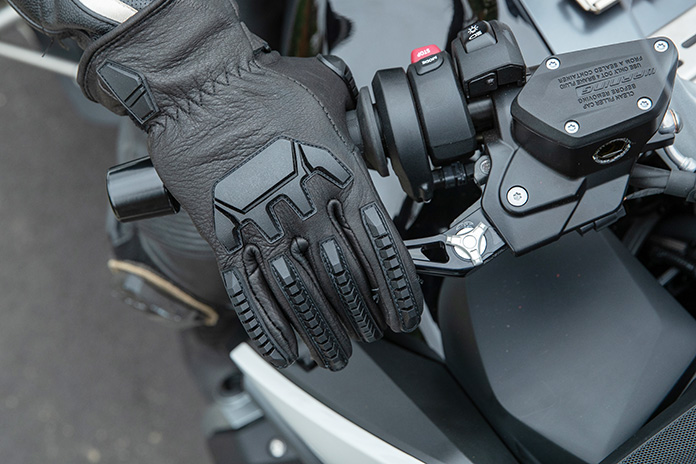
Covering the front brake is a big no-no at most police motor schools across the country. By this, I mean resting any number of your fingers on the front brake lever when not actuating the front brake. Instead, instructors teach riders to keep all fingers on the throttle until you need the brakes, then all fingers on the brake lever. Having been exposed to lots of motorcycle riding disciplines over the last 40 years, I was always curious where this idea originated, as it seems odd not to have all my tools at the ready while riding.
I’ve heard different reasons from motor instructors over the years as to why covering the front brake leads students to eternal damnation. Here are a few:
- Heavy police motorcycles require the strength of all four fingers to effectively slow down during an emergency stop.
- Motor officers will panic and tense up in an emergency, inadvertently jerking the fingers covering the brake lever and causing a crash.
- If you don’t have all four fingers squeezing the brake lever during a collision, the remaining fingers around the throttle could get pinned between the lever and the throttle, causing them to get crushed or severed.
To find a definitive answer, I decided to confer with my old pal Russell Groover out in Florida. A former motor officer and longtime instructor, Russell was instrumental in the creation of the first Basic Motor School used by the Tampa Police Department and later adopted by most agencies in the Southeast in the 1950s. As a youth, Russell grew up racing scrambles and competing in regional hillclimbs, and he was considered a sand specialist in his day, racing enduros down Daytona Beach on his military surplus 1942 Harley-Davidson 45ci. Yep, Russell is a genuine American bad-ass, and if I’m honest, it surprises me that he still takes my calls. But I digress. What did the Oracle tell me?
“Well, Quinn, keep in mind bikes back then had clutches on the floor, shifters on the tank, and front brakes on the left side of the bars, so we were busy just getting through a work shift. All these bikes had basic cable drum brakes, and at best, they were lousy if you had them set up perfectly and the roads were dry. It wasn’t unusual to snap a brake lever pulling so damn hard trying to get the bike to slow down.”
When I brought up the idea of covering the front brake with a few fingers in preparation for emergency braking, Russell just laughed and explained that it wasn’t even a consideration in anybody’s mind back then because even four fingers weren’t enough.
My takeaway is this: A poor braking system demanded far more work (and more fingers) from the rider back then, so they instructed motor officers to access every bit of braking power they could muster, and the training manual reflected it. It makes sense given the antiquated systems they had at the time, but that was 1955. Unfortunately, even with the adoption of hydraulic disc brakes and riders no longer experiencing white-knuckle pulls trying to stop, motor programs have yet to update curriculums, as if we’re still living in the past.
Let’s pretend we’re in the future…say, 2023. You have a motorcycle with big brake rotors, powerful hydraulic calipers, and ABS. We’ll call this system “Brembo.” I know it’s crazy, but we’re talking about the future, so just go with me here. Let’s also assume that you always cover the front brake while riding your motorcycle.
Are these futuristic brakes strong enough to stop you with less than four fingers? Check.
By covering the front brake, are you minimizing your reaction time in an emergency due to your finger(s) being staged for rapid deployment? Check.
Will this enable you to perform smooth trail braking, creating a far more stable chassis during cornering? Check.
Will you now be able to smoothly overlap your controls transitioning from throttle to brakes, further stabilizing the motorcycle and generating better overall traction? Again, check.
Wow, I can’t wait for the future!
Related: Quinn Redeker | Ep. 64 Rider Magazine Insider Podcast
If I haven’t been clear, let me come out and say it: I am a huge proponent of covering the front brake in all riding situations, on pavement and in the dirt. And dammit, if it were up to me, I would allow anybody in your riding group to smack your hand with a heavy ruler every time you failed to do it.
I cover the front brake with my index finger alone and have all-day comfort, dexterity, leverage, and enough force to handle any situation, from gentle slowing to threshold braking. And if you’re wondering, my one finger provides enough pulling power on the lever to brake hard enough for my BMW 1250 RT-P’s ABS to kick in, rain or shine.
Here’s the thing: Motorcycle riding takes loads of coordination, skill, concentration, practice, more practice, good judgment, and maybe even a dash of psychic ability. If you think that by covering the front brake, any unexpected event will overwhelm your senses and cause you to go “condition black,” blindly grabbing a handful of brakes and crashing in a panic, I suggest you consider scrapbooking instead of motorcycling. And because I’m supportive, feel free to use the photos we took of you skipping around in the butterfly sanctuary a few weeks back.
So yes, covering the front brake it is! Great decision. And while this article is more about wrapping your head around the idea of covering the front brake than it is a how-to guide, let’s discuss a few details if you don’t currently employ this technique and want to time warp yourself back to the future.
First, let’s decide what finger(s) we will use. As I mentioned, I use only my index finger and can achieve effective and comfortable braking results on all but my old drum-equipped racebikes, on which I use only two. I recommend you let the overall strength of your braking system be your guide.
We want to make sure we have constant contact with the lever regardless of throttle position so that at any time during the manipulation of your controls, you can effectively apply the front brake. This means the lever needs to be close enough to reach when you twist the throttle, yet far enough to have adequate travel for maximum braking force. A great way to check if your lever is set in a good spot is to give it a firm squeeze and see if it “cages” the remaining fingers you have wrapped around the throttle. In other words, we don’t want the lever to touch your throttle fingers when you apply the brake.
Lastly, you need to familiarize your hand with this new way of interacting with your bike. My recommendation is to sit in your garage with your bike shut off and practice keeping your finger rested on the lever while manipulating your throttle throughout its range of travel. You should be comfortable with this in about the same amount of time it would take you to eat two large chimichangas with an ice-cold beverage. Pay attention to ensure you are manipulating your front brake at all throttle positions. If you can’t apply the brake at a moment’s notice, all is lost.
Once you feel comfortable with this technique in a static setting, ride your bike at slow speeds in your neighborhood or an empty parking lot, working this drill over and over. Keep focus on smooth throttle roll on and smooth front brake application.
Now that you’ve heard my pitch, I’ll make a few assurances should you choose to put on your spacesuit and give this a try. I promise you a greatly increased sense of security, knowing you are ready for an emergency stop at any moment. More critically, your overall braking distances will decrease because your reaction times will improve significantly. And I guarantee you will feel more confident about yourself as a rider the moment you start covering the front brake. Call it Quinn’s win-win-win.
Find Quinn at Police Motor Training. Send feedback to rider@ridermagazine.com.
See all of Quinn Redeker’s “Motor School” articles here.

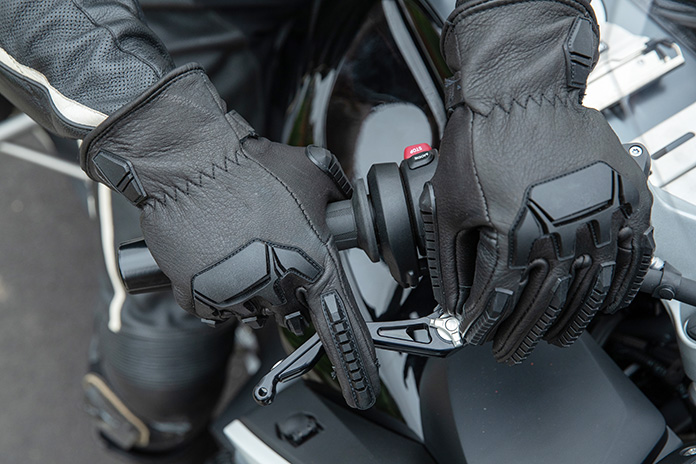
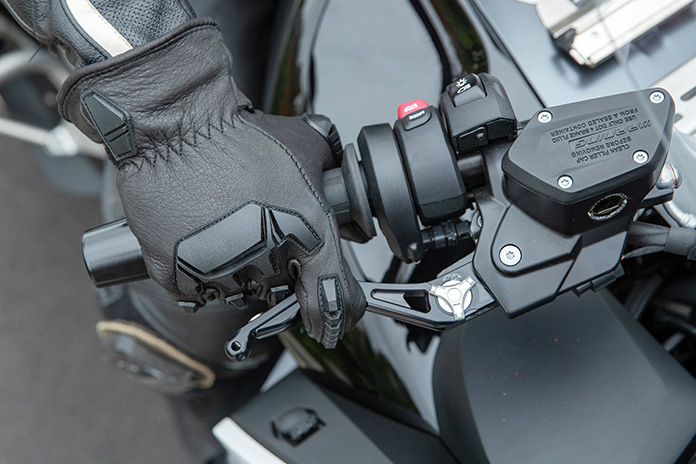
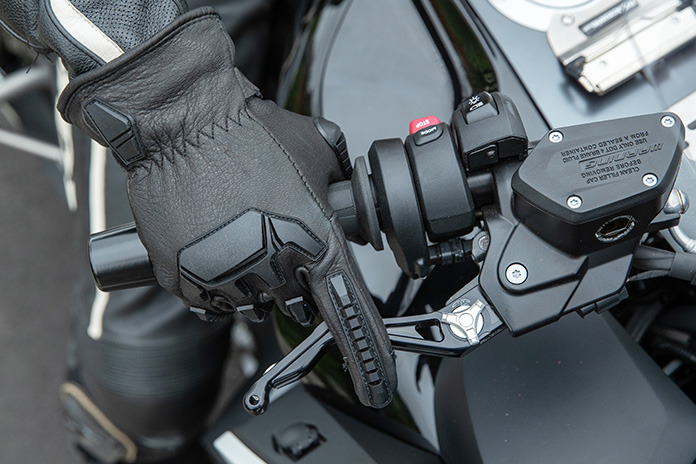
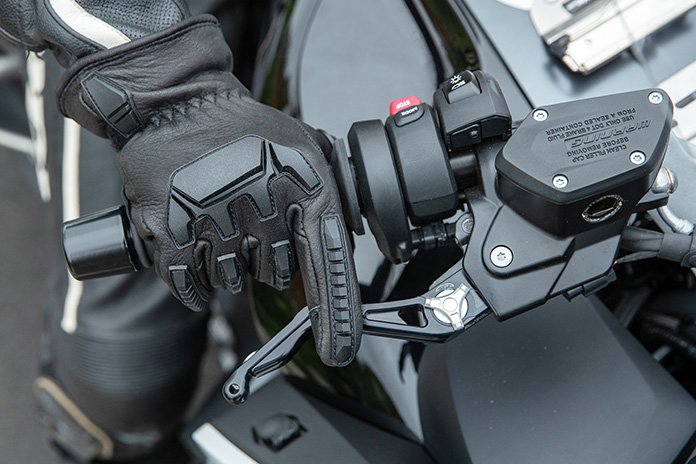








“…feel free to use the photos we took of you skipping around in the butterfly sanctuary a few weeks back.” 😂 Classic. Great article.
I’ve covered my brake and clutch for a few decades now. On my current bike, I ordered a new set of shorter levers (stock levers were adjustable, these are even more). Then I cut them down for a 2 finger cover. I don’t have hand strength issues, just wanted the choice, and 2 fingers are plenty.
I’ve found that with a little research, most levers can be swapped out for at least the pin type adjustable levers (a rotating drum that locks into a pin detent on the lever). All one has to do is bring their lever into a local shop and compare it to the replacement levers on the wall (usually not even much money).